WorkSafe BC 2023 Updates: Anti-Collision Tower Crane Devices
Anti collision devices are more important than ever. Statistical data has shown that unwanted contacts – between two cranes, tower cranes and power lines- are the second most common type of severe tower-crane incidents. Slew-limiting technologies have advanced over the last 20 years and sensors, interfaces, and the software used to analyze the data have become very reliable – improving safe and efficient operations. An example of such technologies is the newly mandated tower crane anti-collision system.
A tower crane anti-collision system is installed to help operators anticipate the risk of contact between the moving parts of a tower crane and other tower cranes and structures. The anti-collision system is composed of various sensors which measure each tower crane’s moving parts, position, velocity, and angle. If a collision becomes imminent, the system can send a command to the crane’s control system–via a radio link, ordering it to slow down or stop. The operator is prevented from moving the crane toward any hazard and can only move it away. Anti-collision systems allow prohibited zones to be defined, called zoning. These include schools, transport links, electrical power lines, and beyond the site boundary, where the crane is not allowed to operate. By taking this approach the construction industry will feel more confident and will be able to avoid costly and fatal incidents. The benefits of these systems make it worthwhile for the industry to explore retrofitting older equipment wherever possible.
WorkSafeBC has revised Guideline 19.24.1, which describes the minimum approach distance to electrical conductors. If employers use a zone-limiting device to prevent dangerous contacts, they will be exempted from providing written assurance of certain safeguards in place.
With these benefits, consultation, changes in guidelines, and public hearings, WorkSafeBC decided to amend the Occupational Health and Safety Regulations, which will be enacted in March 2023. The following revisions are made:
OHSR 19.24.1(2) –If practicable, an employer must ensure that a tower crane operating at a workplace that has exposed electrical equipment or conductors is equipped with a zone-limiting device that prevents the crane from operating in the relevant minimum approach distance
OHSR 14.84.1 – (2)(c.1) if practicable, each crane must be equipped with and operated under the control of a zone-limiting device with anti-collision control
OHSR 14.15 – (2) If a modification that affects the rated capacity or safe operation of a crane or hoist is made to its structure, to one of its mechanical components or to its control system, the crane or hoist must
(a) be assessed,
(b) have its rated capacity adjusted as necessary, and
(c) be certified as safe for use.
See WorkSafeBC for more details. Read more about the amendments here. For any further questions contact us!





